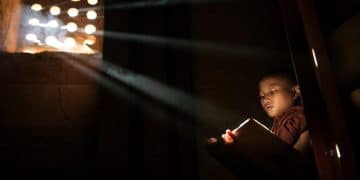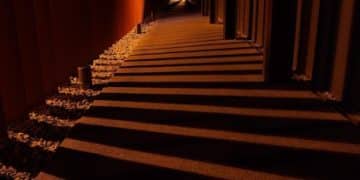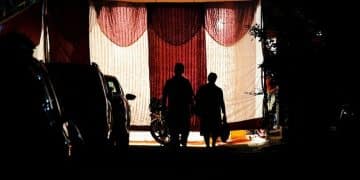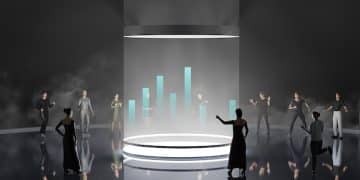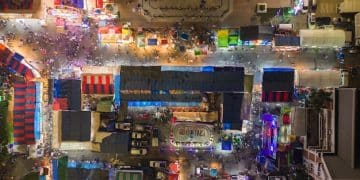The Evolution of Set Design: From Traditional Backdrops to Immersive Experiences

The Evolution of Set Design: From Traditional Backdrops to Immersive Experiences showcases a shift from painted backdrops to complex, interactive environments, enhancing storytelling and audience immersion.
The world of theater is constantly evolving, and one of the most significant transformations can be seen in the realm of set design. The journey The Evolution of Set Design: From Traditional Backdrops to Immersive Experiences has been a long and fascinating one. From simple painted scenes to elaborate, technology-driven environments, set design plays a crucial role in bringing stories to life.
How did we get here, and what does the future hold for set designers and theatergoers alike? Let’s dive in and explore this captivating evolution.
Understanding the Roots of Traditional Set Design
Traditional set design laid the groundwork for everything we see on stage today. It’s important to understand where we started to appreciate how far we’ve come. Early set design focused primarily on painted backdrops, relying on artistry rather than technology to create the desired atmosphere.
The Era of Painted Backdrops
For centuries, theater stages were adorned with meticulously painted backdrops. These backdrops served as the primary visual element, setting the scene and providing context for the unfolding drama.
- Perspective and Depth: Artists employed techniques of perspective to create the illusion of depth on a flat surface.
- Symbolic Representation: Backdrops often used symbolism and imagery to convey deeper meanings and themes within the play.
- Artistic Skill: The quality of the backdrop heavily relied on the skill and creativity of the stage painters.
These traditional methods, while limited by technology, demanded incredible skill and artistic vision. The painted backdrop was more than just scenery; it was an integral storytelling element.

The Shift Towards Realism and Detail
As theater evolved, so did the expectations for set design. Audiences began to crave more realistic and detailed environments, pushing designers to move beyond flat backdrops. This transition marked a significant step in The Evolution of Set Design: From Traditional Backdrops to Immersive Experiences.
Incorporating Three-Dimensional Elements
The introduction of three-dimensional elements brought a new layer of realism to the stage. Designers started incorporating actual objects and structures to create more believable environments.
- Furniture and Props: Real furniture, props, and set pieces replaced painted representations, adding depth and tangibility.
- Architectural Details: Designers began constructing partial walls, doors, and windows to create a sense of enclosed space.
- Layered Sets: Layering different elements in the foreground, middle ground, and background enhanced the sense of depth and perspective.
These additions transformed the stage from a primarily visual experience to a more tactile and immersive one. The integration of real-world objects helped audiences connect with the story on a deeper level.
Technological Advancements and Their Impact
Technology has played a pivotal role in shaping modern set design. From lighting to projections, technological advancements have expanded the possibilities for creating immersive theatrical experiences. This has been a game-changer in The Evolution of Set Design: From Traditional Backdrops to Immersive Experiences.
The Rise of Digital Projections
Digital projections have revolutionized the way set designers create and manipulate environments. Projections can create dynamic and ever-changing backdrops, adding a layer of visual complexity that was previously impossible.
With digital projections, static backdrops can be transformed into dynamic landscapes. Furthermore, projections allow for quick scene changes, enabling a seamless flow between different settings. Also, projections can enhance emotional impact through dynamic visual elements that react to the performance.
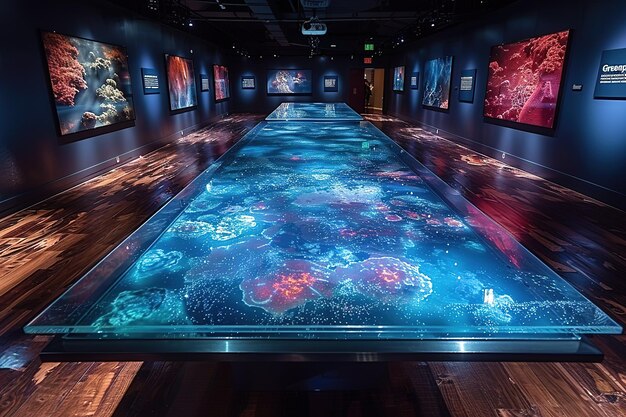
Lighting as a Storytelling Tool
Lighting is no longer just about illuminating the stage; it’s a powerful storytelling tool. Advanced lighting systems allow designers to create mood, highlight specific areas, and even manipulate the audience’s perception of space.
Intricate lighting designs can evoke emotion and atmosphere dynamically. Colors and intensities can shift dramatically to mirror the unfolding narrative. Lighting can also guide the audience’s focus, highlighting key elements of the set and performance.
Immersive Experiences: The Future of Set Design
Today, set design is moving beyond mere scenery to create truly immersive experiences for the audience. This shift is driven by a desire to engage viewers on a deeper, more emotional level. This is the ultimate goal in The Evolution of Set Design: From Traditional Backdrops to Immersive Experiences.
Interactive Sets and Audience Engagement
Imagine a set that responds to the actors’ movements or changes based on audience input. Interactive sets are becoming increasingly common, blurring the line between performer and spectator.
- Sensor Technology: Sensors can track movement and trigger changes in lighting, sound, or projections.
- Audience Participation: Some productions encourage audience members to interact with the set, making them active participants in the story.
- Virtual Reality Integration: VR technology can transport audience members to different locations or perspectives within the performance.
These interactive elements create a sense of presence that traditional set design simply couldn’t achieve. The audience is no longer a passive observer but an active participant in the theatrical experience.
The Designer’s Role: Creativity and Collaboration
The role of the set designer has also evolved, requiring a blend of creativity, technical expertise, and collaborative skills. Designers must work closely with directors, actors, and other members of the production team to bring their vision to life. Understanding how traditional backdrops transformed into The Evolution of Set Design: From Traditional Backdrops to Immersive Experiences is key to the set designer’s creative process.
Balancing Art and Technology
Modern set designers need to be both artists and technicians. They must have a strong understanding of design principles as well as the latest technologies.
Designers must blend artistic vision with technological possibilities. Creative problem-solving is essential to overcome technical challenges. Collaboration with technical teams is critical to successful execution.
Set designers are now integral to storytelling, blending artistry and innovation. Their creativity and expertise drive immersive experiences for audiences.
Challenges and Opportunities in Modern Set Design
While technological advancements have opened up new possibilities, they have also presented new challenges for set designers. Balancing cost, practicality, and artistic vision requires careful planning and execution.
Budget Constraints and Creative Solutions
Limited budgets often force designers to think outside the box, finding creative solutions that maximize impact without breaking the bank.
- Resourcefulness: Designers must be resourceful in sourcing materials and finding affordable alternatives.
- Prioritization: It’s important to prioritize elements that will have the biggest impact on the audience experience.
- Collaboration: Working closely with the director and other team members can help identify cost-effective solutions.
Despite the challenges, modern set design offers unparalleled opportunities for creativity and innovation. By embracing new technologies and pushing the boundaries of what’s possible, designers can create truly unforgettable theatrical experiences.
| Key Point | Brief Description |
|---|---|
| 🎨 Traditional Backdrops | Hand-painted scenes setting the stage’s visual context. |
| 💡 Technological Impact | Digital projections and lighting create dynamic environments. |
| 🎭 Immersive Experiences | Interactive sets engage audiences, blurring performance lines. |
| 🤝 Designer’s Role | Balancing art, tech, and collaboration for impactful designs. |
Frequently Asked Questions
Traditional set design primarily used painted backdrops to depict scenes. These backdrops, often rendered with incredible artistic skill, provided the visual context for the play.
Technology has revolutionized set design through digital projections and advanced lighting systems. These tools allow for dynamic, ever-changing environments and enhance the storytelling process.
Immersive set design aims to engage the audience on a deeper level, often incorporating interactive elements. An interactive set design really helps show The Evolution of Set Design: From Traditional Backdrops to Immersive Experiences
Modern set designers need creativity and technical expertise, as well as the ability to collaborate effectively with directors, actors, and other members of the production team.
Set design provides the visual context, atmosphere, and emotional cues that enhance the narrative. From traditional backdrops to immersive environments, it plays a crucial role in bringing the story to life.
Conclusion
The Evolution of Set Design: From Traditional Backdrops to Immersive Experiences has transformed the theatrical landscape. From the artistry of painted backdrops to the technological marvels of modern stagecraft, set design continues to evolve, enhancing storytelling and enriching the audience experience.
By embracing new technologies and fostering collaboration, set designers are pushing the boundaries of what’s possible, creating unforgettable moments that captivate and inspire. The future of set design is bright, promising even more immersive and engaging theatrical experiences for generations to come.
